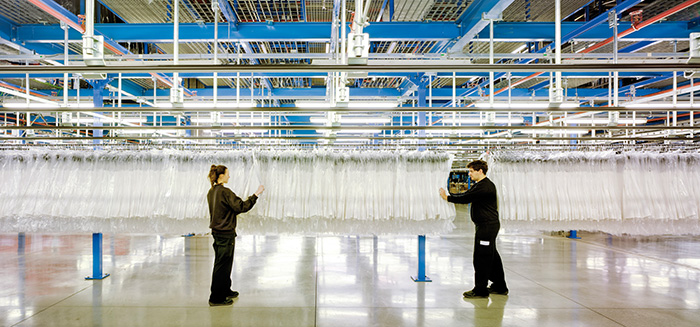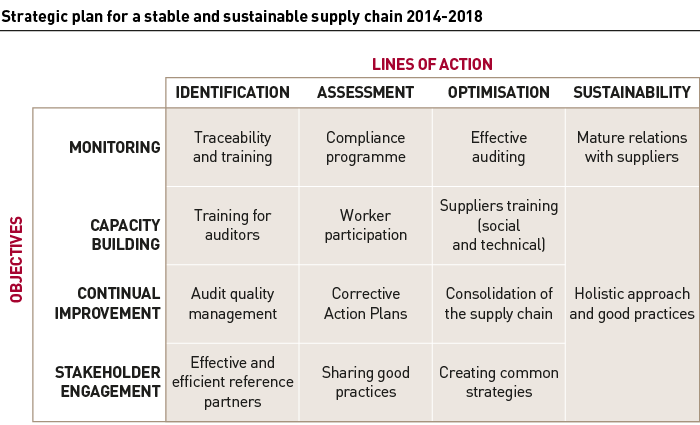Supply chain integrity

Objective
Stable and sustainable supply chain
Opportunity
To secure supply chain management tools and to build innovative and collaborative programmes for their sustainability
Material issues
9. Proximity sourcing
21. Human rights and labour practices in the supply chain
22. Health and safety in factories
24. Equal trading conditions
30. Dialogue with and commitment to the stakeholders
Inditex aims to guarantee a stable and sustainable supply chain. It has two fundamental tools for this: the Inditex Code of Conduct for Manufacturers and Suppliers, which is compulsory for anyone who wants to produce for Inditex, and the Compliance Programme to assure its performance.
A sustainable and robust supply chain is only achieved with constant improvement, which can solely be articulated through social dialogue and coordination with the company’s different stakeholders. In Inditex this dialogue is developed through its own tool, the clusters or groups of suppliers, and also through the Framework Agreement with IndustriALL Global Union, the industry’s international association of unions, which gives rise to numerous joint actions. This is complemented by Inditex’s active participation in international platforms such as the Ethical Trading Initiative and the United Nations Global Compact.
Further information at http://www.inditex.com/en/sustainability/suppliers
Inditex and the guiding principles on business and human rights
The promotion and protection of human, civil, political, economic, social and cultural rights, including the right to development, are the basis of the Guiding Principles on Business and Human Rights developed by the United Nations “Protect, Respect and Remedy” Framework, better known as the Ruggie Framework.
As a socially responsible company, Inditex has developed policies and procedures aimed at defending and promoting human rights both in its operations and those developed by its stakeholders.
In order to implement the Guiding Principles, Inditex has created several instruments, including an Ethics Committee to which any person or organisation directly related to the company may report any breach of these Principles or Inditex’s Codes of Conduct. This Committee may also work on its own initiative, if necessary.
Further information at http://www.inditex.com/en/our_group/our_approach/code_conduct_responsible_practices
| STAKEHOLDERS | PROTECT | RESPECT | REMEDY |
| EMPLOYEES | - Creation and implementation of the Inditex Code of Conduct and Responsible Practices. | - Training in purchasing practices for internal purchasing teams. | - Ethics Committee. |
| SUPPLIERS | - Joint work with other companies, unions and the rest of civil society to mediate with governments on the modification of laws and practices which might breach human rights. - Creation and implementation of the Inditex Code of Conduct for Manufacturers and Suppliers and its relationship with the principles concerning the fundamental rights established in the ILO Declaration on Fundamental Principles and Rights at Work. |
- Compliance Programme to ensure that all suppliers and manufacturers respect human rights in their operations. - Establishment of supplier clusters as tools for dialogue |
- Establishment of Corrective Action Plans for suppliers and manufacturers. - Development of “Plan for the Prevention and Remediation of Work by Minors” wherever this might be necessary. |
| COMMUNITY | - Development of education, employment and health programmes. | - Development of humanitarian action programmes. | - Development of aid programmes in countries affected by conflicts. - Development of emergency programmes. |

In 2013, Inditex approved its strategy for the management of the supply chain, which will run from 2014 to 2018 and which furthers the work that the Group has done in recent years. This strategy is based on two axes:
- lines of action which are based on the identification and thorough knowledge of the Group’s suppliers and manufacturers. An exhaustive assessment is then made of these suppliers and manufacturers to help them improve and make the best use of their own resources, ensuring their sustainability and adjustment to the standards required by Inditex.
- objectives on which the lines of action are based: monitoring, capacity building, continual improvement and stakeholder engagement.

